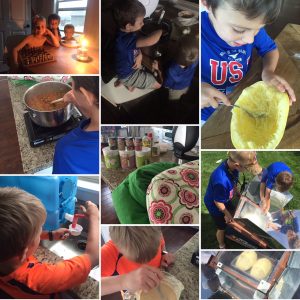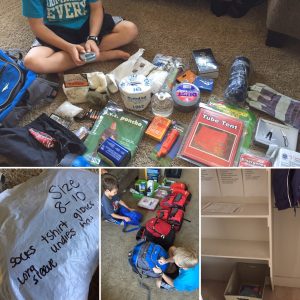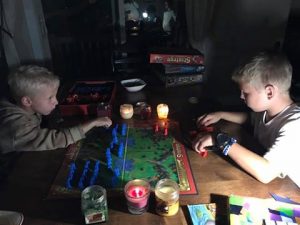We hope you all had a great experience participating in this year’s 7 Day Challenge, whether you actively did each day’s tasks or just read and followed along with the group. Here is a summary of the links to each part of the challenge following the Preparedness Cycle we introduced this year.
DAYS 1-2: PREPARE
These two days were spent preparing for an upcoming “emergency”. Last minute preparations included filling water containers, updating 72 hour kits, and other similar tasks.
DAY 3: PRACTICE – Natural Disaster
Earthquake strikes! An intense earthquake struck your area and knocked out the power lines, gas lines, and city water pipes.
DAY 4: PRACTICE – Family Emergency
Times are tough! Due to some unexpected and rather large medical bills your family has run into financial troubles and you have worked through the majority of your savings.
DAY 5: PRACTICE – Long Term Emergency
Economic meltdown! The country is in turmoil, the trucking industry has shut down, utilities are disrupted (electricity is down but plumbing is still working for now), gasoline is no longer available, your neighbors need help.
DAY 6: PRIORITIZE
Use the provided checklists to brainstorm and create a priority list for what you want to do to go forward with your preparations.
DAY 7: PROCEED
Huge list of resources you can use as you start to do, learn, and buy the items on your priority lists created on Day 6.
Our Findings
Cooking with no power
JULIE: Using the sun oven for the spaghetti squash was awesome. It was a mostly cloudy day but it still cooked. It took a couple hours but I put it in early enough that it didn’t matter. The squash was actually really good because there was no water used so it wasn’t mushy.
Cooking with Thrive meats and veggies was really convenient (like it normally is) but knowing that I had to clean all those dishes by hand made it that much more convenient. It was great to not worry about the dishes I would have used with raw meat being cleaned well enough. It was nice to be able to just throw everything in for the chili and not create more dishes and waste.
Cooking rice in the Saratoga Jacks thermal cooker worked so well. I actually had an activity at church I had to bring the rice to and was really nervous trying it out the first time like this but it turned out perfectly. It really was nice to be able to conserve fuel by only bringing the rice to a quick boil and then letting it sit in the pot for awhile. And it made for really easy transport.
I just absolutely loved my butane stove. I was able to cook right on the counter in my kitchen and was barely disrupted. I do know that you can only store so much butane and would probably be more conservative with it in a long term crisis but it was sure helpful and useful. I had made a pancake mix with powdered eggs and it was pretty easy and yummy breakfasts on the stove. Felt totally normal.

JODI: I usually plan to use my Sun Oven for the bulk of my powerless cooking but the weather was way overcast during the no power days this time. I pulled out my HERC tea light candle oven and was able to make muffins in it just fine. It’s the only tool I’ve found that will allow me to make baked-goods inside without electricity.
I also kept my meals fairly simple which I think is similar to what I would do in a shorter-term emergency. If things extended for a longer period of time I’d have to get more creative and also probably use a lot more dishes to make more complete meals.

Planning
JODI: Since my kids were gone a lot during the days, I spent some time going through my meal plans and working on my inventory lists. Every time I do this I find I tweak my system even more. I’ve changed a lot of my eating habits recently moving towards a more vegetarian diet and that has shifted some of the meals I want to include in my three month list. Instead of storing a lot of meat/dairy freeze-dried items for recipes I’m looking for more recipes that just don’t call for those items. I’m updating my recipe binders to include these new recipes and then incorporating them into my three month excel planner.

Water
JULIE: I calculated how much water we used in one of the days and for a family of 5 it was about 10 gallons. I was REALLY careful with the use and we did shower in buckets and wash dishes. The shower is a good thing to practice because you learn a good order to do things. Use cleaner water first on you then as it gets dirty you can save it for toilet flushing etc.
The laundry was a fun experiment. My son loved plunging through the clothes. The water actually got dirty from the clothes so I know dirt did come out. My concern with laundry without water and power is more in how would the clothes DRY if it were cold and winter time. Also I know we would do laundry a lot less frequently should there be a long term scenario.
JODI: I loved having waterbricks on hand with a spigot so that I could easily use it for cooking, drinking, cleaning, etc. I have large barrels in the garage but whenever I have to actually practice using stored water I much prefer to use the smaller containers. I keep them in my hall closet for easy access and also keep a few more in the basement.
Sanitation
JULIE: Oh man -we literally have a problem practicing this one. Our bags that we were supposed to put the waste in that are biodegradable all broke. Just touching them made them break. We posted a video about it. So we’re back to the drawing board with this one.
JODI: In a previous year we used the bucket with biodegradable bags and when we want to empty it out it exploded all over. This year we decided to just follow the “no flush” rule. Unless it’s a #2 you just leave it in the toilet. Then we used stored water to flush when someone had to poop. In a real emergency situation we may not do this, but there is definitely some “gray water” that we could use for this purpose so it may not be a complete waste.
72 hour kits
JULIE: I changed a few things up with my kits this year that I think I will like. I put each kids clothes in a bag and labeled what was in it and the size. I also put on the outside of the bags what kids clothes were in each backpack with the size. I have found that I always underestimate how long it’s been since I’ve changed those out. I also get a whole new rolling big to add extra foods to that I can rotate every 6 months. I have good long term calorie bars in my kits but I like to have extras like granola bars etc. I put some beef jerky, peanuts, and granola bars in there that I’ll replace completely with new ones and we will eat. So it’s not all these little pieces of foods, just 3 Costco size boxes of each one.

Family Fun
JULIE: In years past my kids have been younger and at school for the challenge. This year they were off school for the whole thing and it really was so much fun to do this challenge as a family. My 9 year old got totally into it. In fact he had a cub scout field trip Friday afternoon and told me not to try doing the laundry by hand until he got home because he wanted to learn how too. I asked him why he liked the challenge so much and he said “because it’s so advanced”… I replied it’s actually primitive … but I’ll take it.
JODI: I had the opposite situation of Julie this year. All of my kids are now in school and busy with activities on weeknights so we didn’t get a lot of time to do fun things with it as a family. They are old enough to understand what’s going on and keep me on my toes if I accidentally turned on the tap or a light, but we didn’t get to have the full experience of living through the entire day in a challenge scenario. We want to try it again when there is a break from school and we have more time to devote to it. We did have some fun nighttime activities without the lights on 🙂


-Jodi Weiss Schroeder
http://foodstoragemadeeasy.net

